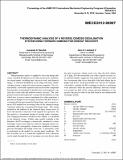Thermodynamic Analysis of a Reverse Osmosis Desalination System Using Forward Osmosis for Energy Recovery
Author(s)
Banchik, Leonardo David; Lienhard, John H
DownloadBANCHIK-IMECE-2012-Final.pdf (1.970Mb)
PUBLISHER_POLICY
Publisher Policy
Article is made available in accordance with the publisher's policy and may be subject to US copyright law. Please refer to the publisher's site for terms of use.
Terms of use
Metadata
Show full item recordAbstract
Thermodynamic analysis is applied to assess the energy efficiency of hybrid desalination cycles that are driven by simultaneous mixed inputs, including heat, electrical work, and chemical energy. A seawater desalination cycle using work and a chemical input stream is analyzed using seawater properties. Two system models, a reversible separator and an irreversible component based model, are developed to find the least work required to operate the system with and without osmotic recovery. The component based model represents a proposed desalination system which uses a reverse osmosis membrane for solute separation, a pressure exchanger for recovering a fraction of the flow work associated with the pressurized discharge brine, and a forward osmosis (FO) module for recovering some of the chemical energy contained within the concentrated discharge brine. The energy attained by the addition of the chemical input stream serves to lower the amount of electrical work required for operation. For this analysis, a wastewater stream of varying solute concentration, ranging from feed to brackish water salinity, is considered as the chemical stream. Unlike other models available in the literature, the FO exchanger is numerically simulated as a mass exchanger of given size which accounts for changing stream concentration, and consequently, stream-wise variations of osmotic pressure throughout the length of the unit. A parametric study is performed on the models by varying input conditions. For the reversible case it is found that significant work reductions can be made through the use of an energy recovery device when the inlet wastewater salinity used is less than the feed salinity of 35 g/kg. For the irreversible case with a typical recovery ratio and feed salinity, significant work reductions were only noted for a wastewater inlet of less than half of the feed salinity due to pump work losses. In the irreversible case, the use of a numerical model to simulate the FO exchanger resulted in a maximum work reduction when the pressure difference between streams was around one half of the osmotic pressure difference as opposed to the precise value of one half found in zero-dimensional exchanger models.
Date issued
2012-11Department
Massachusetts Institute of Technology. Abdul Latif Jameel World Water & Food Security Lab; Massachusetts Institute of Technology. Department of Mechanical EngineeringJournal
Volume 6: Energy, Parts A and B
Publisher
ASME International
Citation
Banchik, Leonardo D., and John H. Lienhard. “Thermodynamic Analysis of a Reverse Osmosis Desalination System Using Forward Osmosis for Energy Recovery.” Volume 6: Energy, Parts A and B (November 9, 2012). © 2012 ASME
Version: Final published version
ISBN
978-0-7918-4522-6